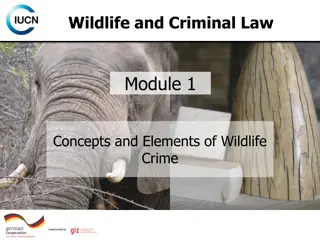Natural Vegetation and Wildlife Sanctuaries in India
The natural vegetation in India varies based on climatic and topographical factors, leading to diverse flora such as Evergreen Rain Forests, Monsoon Deciduous Forests, and Desert ecosystems. The Himalayas showcase vegetation changes with altitude, while factors like soil and topography influence vegetation in specific regions. Moist Tropical Forests, characterized by high rainfall and tall trees, exemplify the unique biodiversity of India's natural landscapes.
Download Presentation

Please find below an Image/Link to download the presentation.
The content on the website is provided AS IS for your information and personal use only. It may not be sold, licensed, or shared on other websites without obtaining consent from the author.If you encounter any issues during the download, it is possible that the publisher has removed the file from their server.
You are allowed to download the files provided on this website for personal or commercial use, subject to the condition that they are used lawfully. All files are the property of their respective owners.
The content on the website is provided AS IS for your information and personal use only. It may not be sold, licensed, or shared on other websites without obtaining consent from the author.
E N D
Presentation Transcript
S. MAHESWARI GUEST LECTURER IN GEOGRAPHY GOVERNMENT COLLEGE FOR WOMEN (A) KUMBAKONAM III B.SC. GEOGRAPHY GEOGRAPHY OF INDIA TITLE : NATURAL VEGETATION AND WILDLIFE SANCTURY IN INDIA DATE : 18.08.2020 & 19.08.2020
NATURAL VEGETATION INTRODUCTION The natural vegetation is the endowments of nature. They grow naturally by following the climatic variables. The types of natural vegetation differ according to precipitation, topography. The cultivated crops and fruits, orchards form part of vegetation, but not naturally vegetation. soil, climate, and
NATURAL VEGETATION IN INDIA India is bestowed with a wide range of flora and fauna. Due to a diverse geographical and climatic condition, an extensive range of natural vegetation grows in India. The main climatic factors are rainfall and temperature. The amount of annual rainfall has a great bearing on the type of vegetation. Annual Rainfall Type of Vegetation 200 cm or more Evergreen Rain Forests 100 to 200 cm Monsoon Deciduous Forests Drier Deciduous or Tropical Savanna 50 to 100 cm 25 to 50 cm Dry Thorny Scrub (Semi-arid) Below 25 cm Desert (Arid)
Temperature is the major factor in Himalayas and other hilly regions with an elevation of more than 900 metres. As the temperature falls with altitude in the Himalayan region the vegetal cover changes with altitude from tropical to sub-tropical, temperate and finally alpine. Soil is an equally determining regions. Mangrove forests, swamp forests are some of the examples where soil is the major factor. Topography is responsible e.g. alpine flora, tidal forests, etc.. factor in few for certain minor types
MOIST TROPICAL FORESTS TROPICAL WET EVERGREEN FORESTS OR RAIN FORESTS Climatic Conditions: Annual rainfall exceeds 250 cm The annual temperature is about 25 -27 C The average annual humidity exceeds 77 percent and The dry season is distinctly short. Characteristics: Evergreen: Due to high heat and high humidity, the trees of these forests do not shed their leaves together. Mesosphytic: Plants adopted to neither too dry nor too wet type climate. Lofty: The trees often reach 45 60 metres in height. Thick Canopy: From the air, the tropical rain forest appears like a thick canopy of foliage, broken only where it is crossed by large rivers or cleared for cultivation. All plants struggle upwards (most ephiphytes) for sunlight resulting in a peculiar layer arrangement. The entire morphology looks like a green carpet when viewed from above.
Less undergrowth: The sun light cannot reach the ground due to thick canopy. The undergrowth is formed mainly of bamboos, ferns, climbers, orchids, etc. Distribution Western side of the Western Ghats (500 to 1370 metres above sea level). Some regions in the Purvanchal hills. In the Andaman and Nicobar Islands. Timber Hardwood: The timber of these forests is fine-grained, hard and durable. It has high commercial value but it is highly challenging to exploit due to dense undergrowth, absence of pure stands and lack of transport facilities [Read previous posts on Climatic regions to understand how lumbering industry works in Equatorial Rainforests (hardwood) and Taiga Climatic (softwood) conditions]. The important species of these forests are mahogany, mesua, white cedar, jamun, canes, bamboo etc.
TROPICAL MOIST SEMI-EVERGREEN FORESTS They are transitional forests between tropical wet evergreen forests and tropical deciduous forests. They are comparatively drier areas compared to tropical wet evergreen forests. Climatic Conditions Annual rainfall is 200-250 cm Mean annual temperature varies from 24 C to 27 C The relative humidity is about 75 per cent The dry season is not short like in tropical evergreen forests. Distribution Western coast Assam Lower slopes of the Eastern Himalayas Odisha and Andamans.
Characteristics The semi-evergreen forests are less dense. They are more gregarious [living in flocks or colonies more pure stands] than the wet evergreen forests. These forests are characterized by many species. Trees usually have buttressed trunks with abundant epiphytes. The important species are laurel, rosewood, mesua, thorny bamboo Western Ghats, white cedar, Indian chestnut, champa, mango, etc. Himalayan region. Timber Hardwood: Similar to that in tropical evergreen forests except that these forests are less dense with more pure stands (timber industry here is better than in evergreen forests).
TROPICAL MOIST DECIDUOUS FORESTS Climatic Conditions Annual rainfall 100 to 200 cm. Mean annual temperature of about 27 C The average annual relative humidity of 60 to 75 per cent. Spring (between winter and summer) and summer are dry. Characteristics The trees drop their leaves during the spring and early summer when sufficient moisture is not available. The general appearance is bare in extreme summers (April-May). Tropical moist deciduous forests present irregular top storey [25 to 60 m]. Heavily buttressed trees and fairly complete undergrowth. These forests occupy a much larger area than the evergreen forests but large tracts under these forests have been cleared for cultivation.
Distribution Belt running along the Western Ghats surrounding the belt of evergreen forests. A strip along the Shiwalik range including terai and bhabar from 77 E to 88 E. Manipur and Mizoram. Hills of eastern Madhya Pradesh and Chhattisgarh. Chota Nagpur Plateau. Most of Odisha. Parts of West Bengal and Andaman and Nicobar islands. Timber These provide valuable timer like Teak. The main species found in these forests are teak, sal, laurel, rosewood, amla, jamun, bamboo, etc. It is comparatively easy to exploit these forests due to their high degree of gregariousness (more pure stands).
SAL AND TIDAL FORESTS They can survive and grow both in fresh as well as brackish water (The mixture of seawater and fresh water in estuaries is called brackish water and its salinity can range from 0.5 to 35 ppt). Occur in and around the deltas, estuaries and creeks prone to tidal influences (delta or tidal forests). Littoral (relating to or on the shore of the sea or a lake) forests occur at several places along the coast. Swamp forests are confined to the deltas of the Ganga, the Mahanadi, the Godavari, the Krishna and the Cauvery. Dense mangroves occur all along the coastline in sheltered estuaries, tidal creeks, backwaters, salt marshes and mudflats. It provides useful fuel wood. The most pronounced and the densest is the Sunderban in the Ganga delta where the predominant species is Sundri (Heriteera). Timber It provides hard and durable timber which is used for construction, building purposes and making boats. The important species found in these forests are Sundri, agar, rhizophora, screw pines, canes and palms, etc.
DRY TROPICAL FORESTS TROPICAL DRY EVERGREEN FORESTS Distribution Along the coasts of Tamil Nadu. Climatic Conditions Annual rainfall of 100 cm [mostly from the north-east monsoon winds in October December]. Mean annual temperature is about 28 C. The mean humidity is about 75 per cent. The growth of evergreen forests in areas of such low rainfall is a bit strange. Characteristics Short statured trees, up to 12 m high, with complete canopy. Bamboos and grasses not conspicuous. The important species are jamun, tamarind, neem, etc. Most of the land under these forests has been cleared for agriculture or casuarina plantations.
Casuarina planta It resembles feathery conifer in general appearance. They are rapid-growing, carefree species for sites and climates as varied as coastal sand dunes, high mountain slopes, hot humid tropics, and semi-arid regions. They have the ability to fix atmospheric nitrogen.It grows 15 to 25 metres in height on an average Distribution Casuarina is the most popular farm forestry in the states of Andhra Pradesh, Tamil Nadu, West Bengal, Odisha, Maharashtra, Gujarat, and Karnataka. Benefits Reduces damage in the event of natural calamities. Line planting in the coastal areas helps in controlling the wind force. It is also used for tourism promotion in view of its ornamental appearance. It provides top quality firewood. The wood is suitable for paper pulp and useful raw material for the manufacture of paper for writing, printing, and wrapping. It is got some serious medicinal values as well. Wasteland development The characteristics which make it a suitable species for wasteland development include adaptability to wide range of habitats, fast growth, salt tolerant, drought resistant, ability to reclaim land and stabilize sand dunes. Intercrops such as groundnut, cucumber, watermelons, sesamum, and pulses can also be raised along with the plantation.
Tropical Dry Deciduous Forests Climatic Conditions Annual rainfall is 100-150 cm. Characteristics These are similar to moist deciduous forests and shed their leaves in dry season. The major difference is that they can grow in areas of comparatively less rainfall. They represent a transitional type moist deciduous on the wetter side and thorn forests on the drier side. They have closed but uneven canopy. The forests are composed of a mixture of a few species of deciduous trees rising up to a height of 20 metres. Undergrowth: Enough light reaches the ground to permit the growth of grass and climbers. Distribution They occur in an irregular wide strip running from the foot of the Himalayas to Kanniyakumari except in Rajasthan, Western Ghats and West Bengal. The important species are teak, axlewood, rosewood, common bamboo, red sanders, laurel, satinwood, etc. Large tracts of this forest have been cleared for agricultural purposes. These forests have suffer from over grazing, fire, etc.
TROPICAL DRY DECIDUOUS FORESTS Climatic Conditions Annual rainfall is 100-150 cm. Characteristics These are similar to moist deciduous forests and shed their leaves in dry season. The major difference is that they can grow in areas of comparatively less rainfall. They represent a transitional type moist deciduous on the wetter side and thorn forests on the drier side. They have closed but uneven canopy. The forests are composed of a mixture of a few species of deciduous trees rising up to a height of 20 metres. Undergrowth: Enough light reaches the ground to permit the growth of grass and climbers. Distribution They occur in an irregular wide strip running from the foot of the Himalayas to Kanniyakumari except in Rajasthan, Western Ghats and West Bengal. The important species are teak, axlewood, rosewood, common bamboo, red sanders, laurel, satinwood, etc. Large tracts of this forest have been cleared for agricultural purposes. These forests have suffer from over grazing, fire, etc.
TROPICAL THORN FORESTS Climatic Conditions Annual rainfall less than 75 cm. Humidity is less than 50 per cent. Mean temperature is 25 -30 C. Characteristics The trees are low (6 to 10 metres maximum) and widely scattered. Acacias and Euphorbiasare very prominent. The Indian wild date is common. Some grasses also grow in the rainy season. Distribution Rajasthan, south-westernPunjab, western Haryana, Kachchh and neighbouring parts of Saurashtra. Here they degenerate into desert type in the Thar desert. Such forests also grow on the leeside of the Western Ghats covering large areas of Maharashtra, Karnataka, Telangana, Andhra Pradesh and Tamil Nadu. The important species are neem, babul, cactii, etc.
DESERT VEGETATION This vegetation occurs west of the Aravallies and comprises short barriers, palm, etc., in the sandy expanse of the Thar Desert.
MONTANE SUB-TROPICAL FORESTS SUB-TROPICAL BROAD-LEAVED HILL FORESTS Climatic conditions Mean annual rainfall is 75 cm to 125 cm. Average annual temperature is 18 -21 C. Humidity is 80 per cent. Distribution Eastern Himalayas to the east of 88 E longitude at altitudes varying from 1000 to 2000 m. Characteristics Forests of evergreen species. Commonly found species are evergreen oaks, chestnuts, ash, beech, sals and pines. Climbers and epiphytes [a plant that grows non-parasitically on a tree or other plant] are common. These forests are not so distinct in the southern parts of the country. They occur only in the Nilgiri and Palni hills at 1070-1525 metres above sea level. It is a stunted rain-forest and is not so luxuriant as the true tropical evergreen. The higher parts of the Western Ghats such as Mahabaleshwar, the summits of the Satpura and the Maikal Range, highlands of Bastar and Mt. Abu in the Aravali Range carry sub-types of these forests.
SUB-TROPICAL MOIST PINE FORESTS Distribution Western Himalayas between 73 E and 88 E longitudes at elevations between 1000 to 2000 metres above sea level. Some hilly regions of Arunachal Pradesh, Manipur, Naga Hills and Khasi Hills. Timber Chir or Chil is the most dominant tree which forms pure stands. It provides valuable timber for furniture, boxes and buildings. It is also used for producing resin and turpentine.
SUB-TROPICAL DRY EVERGREEN FORESTS Distribution Found in the Bhabar, the Shiwaliks and the western Himalayas up to about 1000 metres above sea level. Climatic Conditions Annual rainfall is 50-100 cm (15 to 25 cm in December-March). The summers are sufficiently hot and winters are very cold. Characteristics Low scrub forest with small evergreen stunted trees and shrubs. Olive, acacia modesta and pistacia are the most predominant species.
Wet Temperate forest Moist Temperate forest TEMPERATE FORESTS Dry Temperate forest
MONTANE TEMPERATE FORESTS MONTANE WET TEMPERATE FORESTS Climatic Conditions Grows at a height of 1800 to 3000 m above sea level Mean annual rainfall is 150 cm to 300 cm Mean annual temperature is about 11 C to 14 C and the Average relative humidity is over 80 per cent. Distribution Higher hills of Tamil Nadu and Kerala, in the Eastern Himalayan region. Characteristics These are closed evergreen forests. Trunks have large girth. Branches are clothed with mosses, ferns and other epiphytes. The trees rarely achieve a height of more than 6 metres. Deodar, Chilauni, Indian chestnut, birch, plum, machilus, cinnamomum, litsea, magnolia, blue pine, oak, hemlock, etc. are important species
HIMALAYAN MOIST TEMPERATE FORESTS Climatic Conditions Annual rainfall varies from 150 cm to 250 cm Distribution Occurs in the temperate zone of the Himalayas between 1500 and 3300 metres. Cover the entire length of this mountain range in Kashmir, Himachal Pradesh, Uttarakhand, Darjeeling and Sikkim. Characteristics Mainly composed of coniferous species. Species occur in mostly pure strands. Trees are 30 to 50 m high. Pines, cedars, silver firs, spruce, etc. are most important trees. They form high but fairly open forest with shrubby undergrowth including oaks, rhododendrons and some bamboos. Timber It provides fine wood which is of much use for construction, timber and railway sleepers.
HIMALAYAN DRY TEMPERATE FORESTS Climatic Conditions Precipitation is below 100 cm and is mostly in the form of snow. Characteristics Coniferous forests with xerophytic shrubs in which deodar, oak, ash, olive, etc are the main trees. Distribution Such forests are found in the inner dry ranges of the Himalayas where south-west monsoon is very feeble. Such areas are in Ladakh, Lahul, Chamba, Kinnaur, Garhwal and Sikkim.
ALPINE FORESTS Altitudes ranging between 2,900 to 3,500. These forests can be divided into: (1) sub-alpine; (2) moist alpine scrub and (3) dry alpine scrub. The sub-alpine forests occur lower alpine scrub and grasslands. It is a mixture of coniferous and broad-leaved trees in which the coniferous trees attain a height of about 30 m while the broad leaved trees reach only 10 m. Fir, spruce, rhododendron, etc. are important species. The moist alpine scrub is a low evergreen dense growth of rhododendron, birch etc. which occurs from 3,000 metres and extends upto snowline. The dry alpine scrub is the uppermost limit of scrub xerophytic, dwarf shrubs, over 3,500 metres above sea level and found in dry zone. Juniper, honeysuckle, artemesia etc. are important species.
WILDLIFE IN INDIA India biodiversity, resources, unique species of flora and fauna that roam free in the huge number of nature reserves and protected sanctuaries in this enormous country. They are a true haven for nature and wildlife lovers that flock to terrains and thick jungles in huge numbers every year. boasts of a rich vast natural very and some wildlife these green
The Indian fauna consists of over 80,000 (including 6,500 invertebrates 5,000 mollusca, 2,546 fishes, 1228 birds, 458 mammals, 204 ampjibians, 446 reptiles, 4 panthera) and 60,000 species of insects. Prater (1934) has divided India into six Zoo-geographical regions: They are 1. Himalayan region, 2. Northern Mains, 3. Rajasthan Desert, 4. Penninsular Plateau, 5. Malabar Coast, and 6. Nilgiri .
The Indian Board of Wildlife was constituted in 1985 for an all-round development of wild animals and birds in the country. Wildlife management in India has the following objectives : 1. Safeguarding the natural habitat of wild animals. 2. Maintenance of animals and birds in their protected areas. 3. Protecting wildlife through legislation and Acts. 4. Establishing biosphere reserves for plant and animals.
ESTABLISHEDWILDLIFESANCTURIESININDIA Wildlife sanctuaries of India are classified as IUCN Category IV protected areas. Between 1936 and 2016, 543 wildlife sanctuaries were established in the country that cover 118,918 km2(45,914 sq mi) as of 2017.Among these, the 50 tiger reserves are governed by Project Tiger, and are of special significance for the conservation of the Bengal tiger.
25 Best Wildlife Sanctuaries In India. Look at all these wildlife sanctuaries of India sheltering rare and exotic species of plants, animals, and birds and take your pick. Out of the 543 sanctuaries here, these are the most favorite of wildlife enthusiasts and nature fanatics who understand the true importance of wildlife sanctuaries.
Bhadra Wildlife Sanctuary, Karnataka Tadoba Andhari Tiger Reserve, Maharashtra Chinnar Wildlife Sanctuary, Kerala Dandeli Wildlife Sanctuary, Karnataka Bhagwan Mahavir Wildlife Sanctuary, Goa Interview Island Wildlife Sanctuary, Andaman Kutch Desert Wildlife Sanctuary, Gujarat Karakoram Wildlife Sanctuary, Jammu And Kashmir Indian Wild Ass Sanctuary, Gujarat Dibang Wildlife Sanctuary, Arunachal Pradesh Rollapadu Wildlife Sanctuary, Andhra Pradesh Grizzled Squirrel Wildlife Sanctuary, Tamil Nadu Eaglenest Wildlife Sanctuary, Arunachal Pradesh
Koyna Wildlife Sanctuary, Maharashtra Tamor Pingla Wildlife Sanctuary, Chhattisgarh Senchal Wildlife Sanctuary, West Bengal Periyar Wildlife Sanctuary, Kerala Govind Wildlife Sanctuary, Uttarakhand Chilka Wildlife Sanctuary, Odisha Nauradehi Wildlife Sanctuary, Madhya Pradesh Manas Wildlife Sanctuary, Assam Mundanthurai Wildlife Sanctuary, Tamil Nadu Indira Gandhi Wildlife Sanctuary, Tamil Nadu Landfall Island Wildlife Sanctuary, Andaman Eturnagaram Wildlife Sanctuary, Telangana























